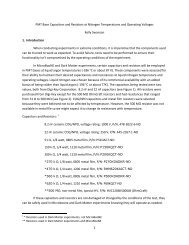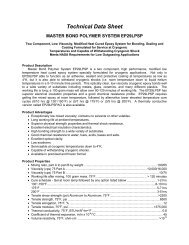PMD-1208LS User's Guide - LArTPC DocDB
PMD-1208LS User's Guide - LArTPC DocDB
PMD-1208LS User's Guide - LArTPC DocDB
You also want an ePaper? Increase the reach of your titles
YUMPU automatically turns print PDFs into web optimized ePapers that Google loves.
<strong>PMD</strong>-<strong>1208LS</strong> <strong>User's</strong> <strong>Guide</strong>Functional DetailsGain error is a change in the slope of the transfer function from the ideal, and is typically expressed as apercentage of full-scale. Figure 3-12 shows the <strong>PMD</strong>-<strong>1208LS</strong> transfer function with gain error. Gain erroris easily converted to voltage by multiplying the full-scale (FS) input by the error.The accuracy plots in Figure 3-12 are drawn for clarity and are not drawn to scale.Input Voltage+FSIdealGain error=+0.2%, or +20 mVGain error=-0.2%, or -20 mVActual0 2048 4095Output Code-FSFigure 3-12. ADC Transfer function with gain errorFor example, the <strong>PMD</strong>-<strong>1208LS</strong> exhibits a typical calibrated gain error of ±0.2% on all ranges. For the±10 V range, this would yield 10 V × ±0.002 = ±20 mV. This means that at full scale, neglecting theeffect of offset for the moment, the measurement would be within 20 mV of the actual value. Note thatgain error is expressed as a ratio. Values near ±FS are more affected from an absolute voltage standpointthan are values near mid-scale, which see little or no voltage error.Combining these two error sources in Figure 3-13, we have a plot of the error band of the <strong>PMD</strong>-<strong>1208LS</strong>for the ±10 V range. This is a graphical version of the typical accuracy specification of the product.The accuracy plots in Figure 3-13 are drawn for clarity and are not drawn to scaleInput Voltage+FSIdeal +9.77mV + 20 mVIdealIdeal -(9.77mV + 20 mV)9.77mV0 2048 4095Output CodeIdeal +9.77mV + 20 mVIdealIdeal -(9.77mV + 20 mV)-FSFigure 3-13. Error band plot3-11
















